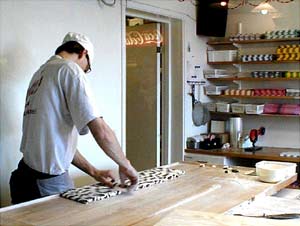Global Tales from Two Young
Travelers
Gränna
By
Emily Reisch and Jon Minor
One rainy Saturday morning, Jon’s host family
took us to Gränna. It’s about a half-hour drive from Jönköping.
The school matches students with families so they can experience more
than just the student life in Jönköping.
Christer, Ulla, and their daughter Marina had invited us over for Swedish
meatballs previously. Ulla is an English teacher, and we’d spoken
to her class of 15- and 16-year-olds about South Dakota. She wanted
them to hear English without a Swedish accent and to practice speaking.
We’re getting used to it, but are still quite impressed with the
fluency in English here.
Gränna is best known as the home of polkagris. Polkagrisen are
sticks of red and white striped peppermint candy. It is sold all over
Sweden, but Gränna is the only place it’s made.
 Gränna
is a small, quaint town with rows of polkagrisen shops lining the main
street. Forested hills rise above the rooftops, and the town sits on
the east coast of Lake Vättern.
Gränna
is a small, quaint town with rows of polkagrisen shops lining the main
street. Forested hills rise above the rooftops, and the town sits on
the east coast of Lake Vättern.
Every shop has a window to the kitchen where the candy is made. We watched
a man take a chunk of soft white dough and start rolling it on a counter.
He added a thin piece of red dough, rolled it a bit more, and then swung
the rope of candy around to create red twists.
He repeated this many times, rolling the candy into thinner sticks,
cutting it in half, and giving it a few twists for spiraling red stripes,
until he had many sticks of half-inch thick candy about as long as pencils.
As the candy cools, it gets hard. The sticks were quite stiff when he
was finished rolling them, but he put them into a wood frame. It rocked
back and forth, with the sticks rolling from end to end, and a fan finished
cooling the candy sticks.
The shops are every kid’s dream. Row after row of candy lines
the shelves. Actually, this really isn’t different from any Swedish
grocery or movie rental store. Every one has many bins of bulk candy
to satisfy the Swedish sweet tooth. We think movies and popcorn go together;
Swedes think candy.
The difference in Gränna is that it’s all different flavors
and shapes of polkagrisen. We picked up a few traditional peppermint
sticks, along with pear, brown sugar, caramel, strawberry and raspberry
flavors. Jon’s nephews will enjoy the taste of Sweden we bring
back.
No trip to Gränna would be complete without also visiting Visingsö.
Legend says the giant Vis and his wife were walking home from a party
one evening and his wife couldn’t quite step over the lake. He
picked up a piece of earth and threw it into the lake so she wouldn’t
get her feet wet. The piece he threw became the island of Visingsö.
We boarded a small ferry that took us there in half an hour. The island
is perfect for cycling around. It’s very flat, small, and only
a few kilometers wide. We rented bikes and started pedaling.
The island has many of the traditional red houses and barns seen throughout
Sweden. It also has a lot of farmland, with crops, sheep and cattle.
We stopped for lunch by a pasture full of Holsteins.
Ulla had baked a chicken pie, which is common at parties and picnics.
It had chicken, cheese, bell peppers, and mushrooms filling inside the
crusts.
We stopped at two old churches. One had a tower that we could climb.
We had to squeeze through a narrow staircase with rock steps, then climb
very steep wooden stairs to the top. The view of the entire island,
Gränna, and Lake Vättern was worth it.
We also explored the ruins of an old castle before getting back on the
ferry and heading home.